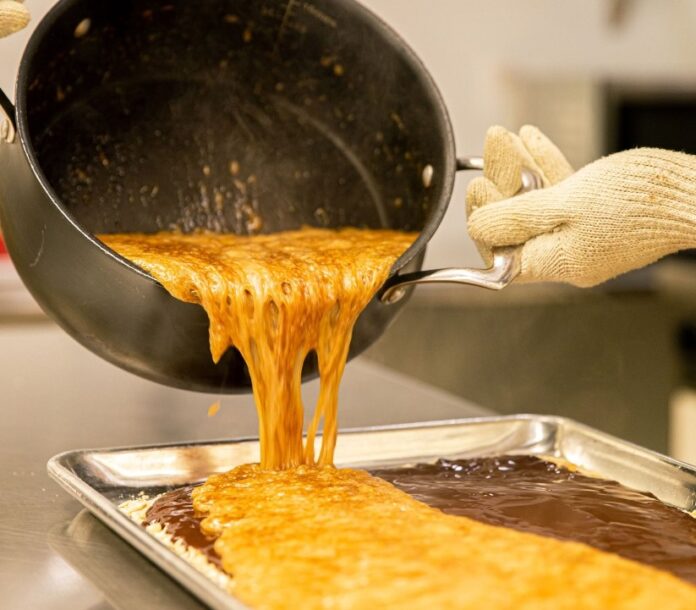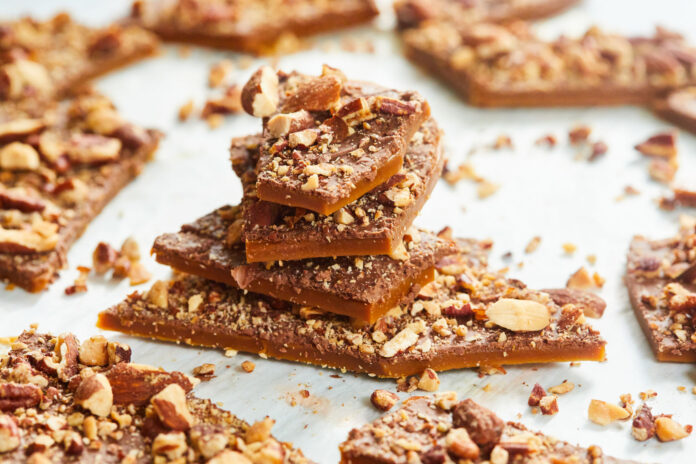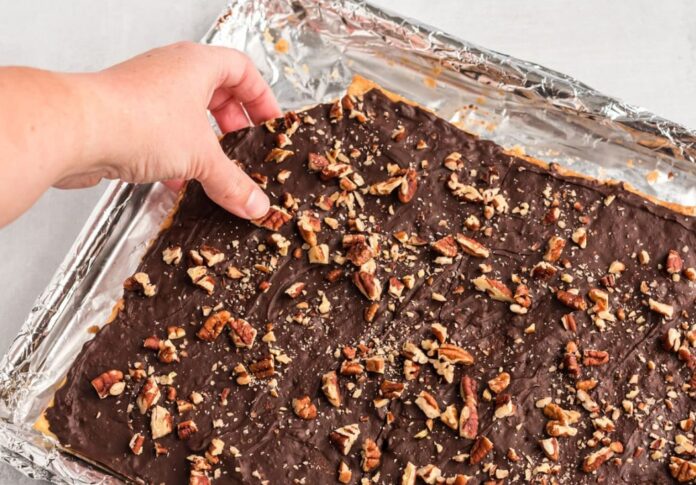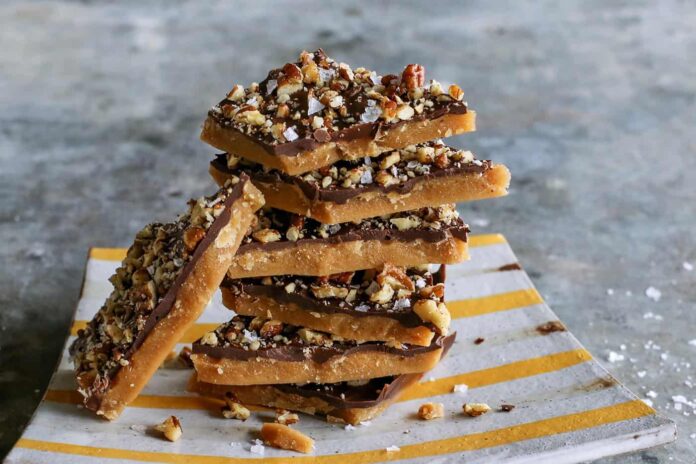Imagine standing in a cozy kitchen, where the rich and buttery aroma of toffee fills the air, enticing anyone who enters. This is more than just a sweet treat; it’s a creation infused with love and nostalgia. Every holiday season, families gather around, sharing stories and laughter, often accompanied by the irresistible crunch of homemade toffees. It’s that moment—watching loved ones savor each bite—that makes candy making truly special.
Making toffees at home may seem daunting at first, but it opens doors to creativity. With the right guidance, anyone can master the art of toffee making. Also, you can even open a restaurant where you will offer this delight. If you need new ideas for design, check this.
This guide to homemade sweets provides the perfect opportunity to create memorable holiday treats, impressing friends and family alike. Whether you’re a seasoned candy maker or a curious beginner, this step-by-step article will empower you with the knowledge and techniques to make perfect homemade toffees.
Key Takeaways
- Homemade toffees are a delicious gift during holidays.
- Two key components are butter and sugar; they create the base of flavor.
- Temperature and timing are crucial to achieving the ideal consistency.
- Using a heavy-bottomed saucepan helps prevent burning.
- Perfect toffee can be achieved by mastering simple techniques.
- The right ingredients contribute to flavor and texture.
Introduction to Homemade Toffees

Homemade toffee has a special place in the hearts of many, especially during the festive season. This beloved treat combines rich flavors and a delightful crunch, making it a favorite among holiday treats. The process of candy making is not only a culinary endeavor but also an opportunity to create lasting memories with loved ones.
When it comes to easy sweets, toffee stands out due to its versatility. It can be enjoyed on its own or incorporated into various desserts. With an abundant array of toffee recipes available, cooking up a batch gives individuals the chance to personalize their confections. Handcrafted sweets often convey a level of care and thoughtfulness that store-bought variations simply cannot match.
The charming tradition of making homemade toffee can enhance gatherings and celebrations. Offering these sweet delights as party favors brings warmth and joy to any occasion. There’s something undeniably satisfying about the process, from the first stir of sugar to unraveling the final product. This experience not only delivers delightful flavors but also fosters connections with family and friends, particularly during long-cherished holiday traditions.
Understanding the Science of Toffee Making
Toffee making combines art and science, rooted in the chemistry of sugar and butter. Mastering these elements can lead to the perfect toffee, and understanding candy science provides valuable insights into this delicious craft.
The interplay of ingredients reveals the essence of sugar and butter chemistry. When sugar is heated, it undergoes a process called caramelization. This transformation impacts flavor, texture, and color. The introduction of butter adds richness and smoothness, creating a sublime consistency that defines quality toffee.
Temperature plays a significant role in differentiating between various confections. The precise cooking technique for toffee involves reaching specific temperature milestones, such as:
- Soft Ball Stage (234°F – 240°F): Ideal for chewy candies.
- Firm Ball Stage (244°F – 248°F): Perfect for toffee’s desired firmness.
- Hard Crack Stage (300°F – 310°F): Essential for a crunchy texture.
Understanding these stages helps in achieving the desired characteristics of toffee. A brief overview of the different types of confections offers clarity on their textures and flavors:
| Type | Key Characteristics |
| Toffee | Crunchy with a buttery flavor, achieved through high temperature. |
| Caramel | Softer, chewy texture with rich sweetness, made with a lower cooking temperature. |
| Butterscotch | Similar to caramel but uses brown sugar, resulting in a deeper flavor profile. |
Implementing effective toffee making tips can enhance the outcome of homemade confections. The journey to the perfect toffee becomes clearer as knowledge of candy science enhances skills in the kitchen. Each cooking session enriches the experience and fosters a love for this timeless treat.
Essential Ingredients for Homemade Toffees

Creating perfect homemade toffees requires careful attention to essential toffee ingredients. Each component plays a critical role in achieving the desired flavor and texture in this beloved confection. Understanding the functions of butter, sugar choices, and salting in candy making will elevate any toffee recipe.
Butter ─ The Foundation of Flavor
Butter serves as the primary fat in toffee recipes, adding richness and depth to the flavor profile. It contributes to the smooth texture that defines quality toffee. When selecting butter, opt for unsalted varieties to control the salt content in the final product, ensuring a balanced sweetness. The quality of butter directly impacts the overall taste of homemade sweets, making it a key ingredient in any toffee creation.
Sugar Choices ─ Granulated vs. Brown Sugar
Sugar is another essential toffee ingredient that influences sweetness, texture, and color. Granulated sugar is commonly used for its ability to create a crisp texture and a classic toffee tone. In contrast, brown sugar contains molasses, imparting a deeper flavor and softer texture. Each type of sugar contributes differently to the final product, so understanding the differences in these sugar choices allows for customization based on personal preferences.
Salting to Perfection
Salting in candy making is often underestimated but plays a crucial role in enhancing the flavor of toffees. A hint of salt can balance sweetness and elevate the overall taste experience. Adding salt at various stages of the cooking process can affect the final profile of the toffee. Experimenting with salt levels allows for discovering personal flavor preferences, proving that even small adjustments can make a significant impact on homemade delights.
| Ingredient | Type | Flavor Profile | Texture Contribution |
| Butter | Unsalted | Rich and creamy | Smooth and velvety |
| Sugar | Granulated | Neutral sweetness | Crisp texture |
| Sugar | Brown | Deep and caramel-like | Soft and chewy |
| Salt | Table or sea salt | Enhances sweetness | Balances overall flavor |
How to Make Perfect Homemade Toffees

Crafting perfect homemade toffees requires careful attention to detail and a solid understanding of the necessary steps. By following precise toffee preparation steps, anyone can enjoy the indulgent flavors of freshly made toffee. This section outlines the step-by-step process and explains how to achieve the desired temperature to ensure perfect toffee consistency.
Step-by-Step Process for Toffee Preparation
To begin the journey of how to make toffee, gather the essential ingredients and tools. A heavy-bottomed saucepan, sugar, butter, and a candy thermometer are vital for success. Here are the toffee preparation steps to follow:
- Combine sugar and butter in a heavy-bottomed saucepan.
- Cook on medium heat, stirring constantly until the mixture begins to boil.
- Attach a candy thermometer to the side of the pan, ensuring it does not touch the bottom.
- Continue cooking, stirring frequently, until the mixture reaches the hard crack stage (about 300°F or 149°C).
- Remove the saucepan from heat and pour the mixture onto a greased baking sheet.
- Allow the toffee to cool completely before breaking it into pieces.
Getting the Right Temperatures and Consistency
Mastering candy making techniques is essential for achieving perfect toffee consistency. The cooking temperature of the toffee mixture plays a crucial role. Following these guidelines will help ensure success:
- Use the candy thermometer to monitor the temperature closely.
- Stir continuously to prevent the mixture from burning and to ensure even cooking.
- Experiment with slight temperature adjustments based on your stove’s heat output, as this can vary widely.
With the right techniques in place, achieving a delightful batch of toffee is well within reach for any candy lover. The use of precise temperatures and consistent stirring will lead to a texture that is both flavorful and inviting. Enjoy the process and savor the results!









